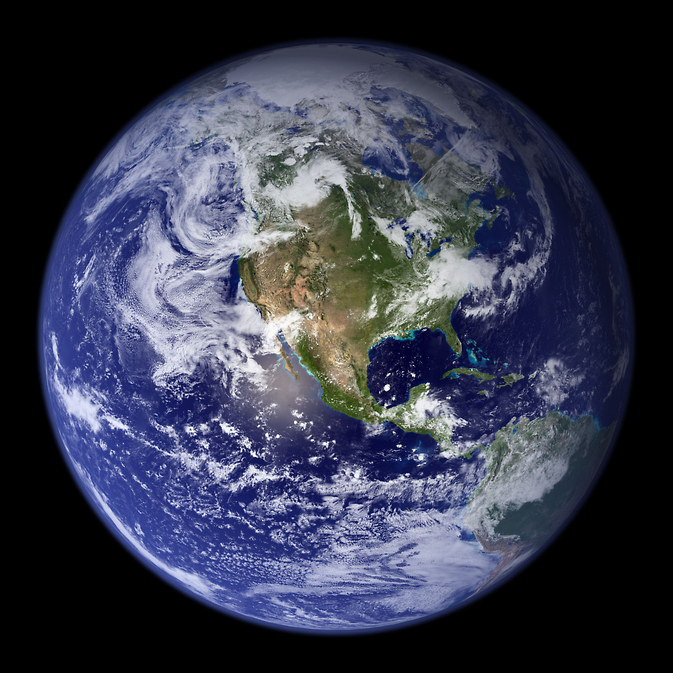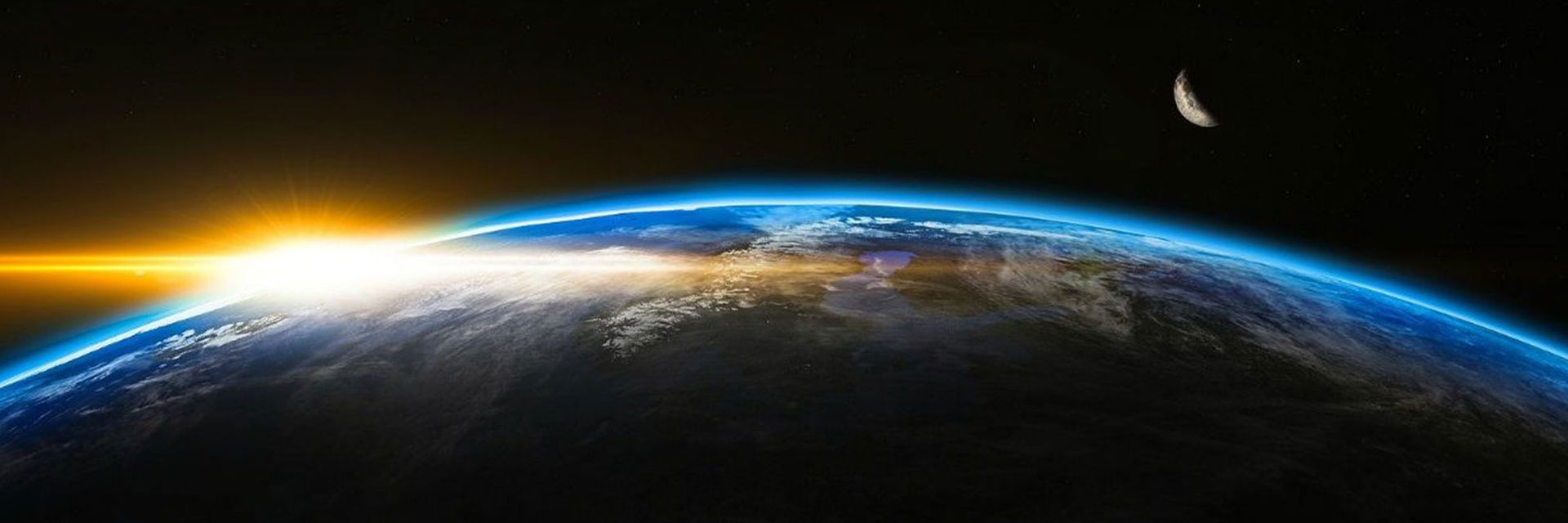When astronauts see the Earth from space, they often experience a sense of awe and clarity known as the Overview Effect. This feeling can trigger a sense of cosmic interconnectedness, unity, and responsibility. Even a photograph of the Earth taken from space can have amazing effects, and indeed, the photograph known as “Earthrise” was instrumental in inspiring the first Earth Day in 1970. Now, on the 50th anniversary of that momentous event, the Overview Effect might be more valuable and necessary for the survival of the human race than ever before.
◊
In April 1961, Yuri Gagarin became the first human to orbit the Earth. When he touched back down on solid ground, he had been most profoundly affected not by his new window into the infinite cosmos around him – but by the sight of Earth, his home planet, spinning against a sea of darkness. “Circling the Earth in my orbital spaceship, I marveled at the beauty of our planet,” he said. “People of the world, let us safeguard and enhance this beauty, and not destroy it.”
Only eight years later, astronauts setting foot on the Moon experienced a similar sensation. Buzz Aldrin, Neil Armstrong, and Michael Collins stared down over the blue and green planet, that “brilliant jewel in the black velvet sky,” as Aldrin described it, and experienced a profound and stunning sense of clarity.
 Astronaut Ed Aldrin on the Moon, July 20, 1969 (Credit: NASA/JPL/CalTech)
Astronaut Ed Aldrin on the Moon, July 20, 1969 (Credit: NASA/JPL/CalTech)
The sensations triggered by the sight of the planet from space are so moving and life-changing that the experience has its own name: the Overview Effect. Across the board, the feeling of seeing the Earth from above always seems to have a powerful, paradigm-shifting effect on the human spirit.
Origins of the Overview Effect
The term “the Overview Effect” was coined by author and space philosopher Frank White, who conceptualized the moniker in 1987 as he was flying in an airplane across the country.
“The Overview Effect is a message from the universe to humanity. The message is that the Earth, when seen from orbit or the moon, is a whole system, where borders and boundaries disappear, and everything is interconnected. . . . We are the crew of a natural spaceship called Earth. . . . As so many people around the world have realized, humanity stands at a crossroads, and we willeither choose to hear the message of the Overview Effect, or we will continue on a path that is destructive to ourselves and our planet.” – Frank White, “The Overview Effect”
Astronauts, of course, experience the Overview Effect much more intensely than any ordinary airplane rider might. Most astronauts seem to experience three things when they see the Earth from above. First, they realize the insignificance and fragility of life. But then they experience a sense of interconnectedness and shared responsibility to the Earth – an understanding that we’re all just atoms within a larger entity. Finally, they’re struck by a desire to fight for the future. A common consequence of the Overview Effect is a sense of increased social responsibility, a desire to transcend borders and to protect our shared home and all its inhabitants.
Russell “Rusty” Schweickart, who flew to space on the Apollo 9 mission in 1969, experienced a euphoric, transcendent sensation when seeing the Earth from above. “When you go around the Earth in an hour and a half, you begin to recognize that your identity is with that whole thing,” he said.

Earth from space (Credit: NASA's Earth Observatory)
Edgar Mitchell, an astronaut on Apollo 14, echoed these sentiments. “You develop an instant global consciousness, a people orientation, an intense dissatisfaction with the state of the world, and a compulsion to do something about it,” he said in an interview. “From out there on the moon, international politics look so petty. You want to grab a politician by the scruff of the neck and drag him a quarter of a million miles out and say, ‘Look at that, you son of a bitch.’”
The effects of the Overview Effect are lifelong, and they’ve been compared to the feeling of falling in love or seeing your child for the first time. Astronauts who see the Earth from space experience a radical sense of oneness with the planet and its inhabitants, and a sense that divisions and borders are totally arbitrary.
Transcendence From Above: Psychology of the Overview Effect
Scientists explain that “earth-gazing” (or seeing the planet from above) can trigger psychological phenomena like self-transcendent experiences (STEs) and awe, both of which are powerful and sometimes life-changing.
Awe is when “you don’t feel like you [can] wrap your mind around it completely,” says Craig Anderson, a PhD candidate at Berkeley. Awe can actually result in a shift in the way we understand the world, leading us to question preconceived notions and helping us dissolve the borders of our own minds. One study found that awe can diminish selfish concerns and can increase altruism; others have shown that awe can enhance patience, creativity, and generosity. You don’t have to go to space to experience awe, but gazing at a photo and imagining what it’s like might help.
“It seems that Earth gazing can strengthen our connection to nature and life, elicit awe, gratitude, humility, and reverence, and enable a sense of social cohesion. These features suggest it can instigate behavioural change and foster wellbeing, and therefore make it relevant to Counselling Psychology. . . . This experience can be adapted and simulated via positive technologies, such as virtual reality (VR), as a green wellbeing intervention at an individual, local, and global level.” – A. Nezami, The overview effect and counselling psychology: astronaut experiences of earth gazing, University of London
The Overview Effect can also trigger STEs, which are sensations that create the feeling of selflessness and connection to things outside the self. Self-transcendence happens during mystical experiences and meditation, through love, and even through listening to music. And, of course, many astronauts experience a self-transcendent feeling when they see the Earth from space. These feelings can create lasting change that stays with the people who experience them for the rest of their lives.
The psychologist David Yaden studies the Overview Effect and other STEs. In his study “The overview effect: Awe and self-transcendent experience in space flight,” he places the self-transcendent experience of seeing the Earth from space in the context of other altered states. He compared quotes from astronauts, tracing terms like “unity” and “interconnectedness” as common themes. Eventually, Yaden hopes that his research might help reveal a way to spread the Overview Effect – and the feelings of loving-kindness it entails – to more people. (His observations might also be relevant for the era of coronavirus quarantine, as the study also has “potential implications for better understanding well-being in isolated, confined, extreme environments”).
50 Years of Earth Day: Earthrise and the Modern Environmental Movement
In 1968, during the Apollo 8 mission, astronaut William Anders snapped a photo of the Earth and some of the Moon’s surface. This photo – which shows our planet half shrouded in darkness, rising up through outer space – became known as “Earthrise,” and nature photographer Galen Rowell later described it as “the most influential environmental photo ever taken.”
 "Earthrise" as photographed from Apollo 8 (Credit: Bill Anders/NASA)
"Earthrise" as photographed from Apollo 8 (Credit: Bill Anders/NASA)
Anders’s photo helped kick the environmental movement into high gear, ultimately inspiring the first Earth Day celebration in 1970. Many people who saw the image experienced a vicarious version of the Overview Effect. Some who saw it felt the calling of a higher power or purpose. Others believed it proved the existence of God or a higher order, and still others saw it as a call to act and defend life on Earth.
“As I looked down at the Earth – this stunning, fragile oasis, this island that has been given to us, and that has protected all life from the harshness of space – a sadness came over me. . . . I couldn’t help thinking of the nearly one billion people who don’t have clean water to drink, the countless number who go to bed hungry every night, the social injustice, conflicts, and poverty that remain pervasive across the planet. Seeing Earth from this vantage point gave me a unique perspective. . . . Part of this is the realization that we are all traveling together on the planet and that if we all looked at the world from that perspective we would see that nothing is impossible.” – NASA astronaut Ron Garen, The Orbital Perspective”
Sixteen months after Earthrise debuted, 20 million people took to the streets in America to protest the destruction of the Earth. The first Earth Day, which remains the largest civic event in human history, was inspired by a sequence of increasingly catastrophic natural disasters. The fire that overtook the polluted Cuyahoga River in Ohio and the Santa Barbara oil spill in California were just two of the events that highlighted the devastating effects of human industry, inspiring the protest, but the Earthrise photo also played a role in reminding people of their shared responsibility to the planet. Eventually, that first Earth Day protest led to the creation of the Environmental Protection Agency and the institution of some of our strongest environmental laws.

The first Earth Day, April 22, 1970, in Washington, D.C. (Credit: U.S. National Park Service, via Wikimedia Commons)
Earth Day 2020 and the Continued Relevance of the Overview Effect
This April, we celebrate the 50th anniversary of that first Earth Day celebration – and thanks to the onset of climate change, we face a more perilous future than ever before. Today, our species faces potential extinction from rising global temperatures, which are already wreaking havoc on the world in the form of outbreaks of infectious diseases, and which will only continue to destroy our natural habitat and our communities if people across the globe do not undertake a concerted effort to combat climate change.
Therefore the Earthrise image may be more relevant than ever in this day and age. After all, the Overview Effect isn’t only about realizing how small we are; it’s also about the fact that as fellow occupants of this great blue and green spaceship, we all have a shared responsibility, and we all need to act to defend our home and our communities.
“During a spaceflight, the psyche of each astronaut is re-shaped; having seen the sun, the stars and our planet, you become more full of life, softer. You begin to look at all living things with greater trepidation and you begin to be more kind and patient with the people around you.” —Boris Volynov, Soviet cosmonaut
So this Earth Day, spend some time looking at these photos of the Earth, letting their significance wash over you. Then sign up to participate in a digital Earth Day action, and even consider joining an environmental organization.
If you’re looking for inspiration, consider the Overview Effect, and consider what those astronauts all realized up there in the dark: We’re all stitches in a great cosmic web, all connected to each other and our home, spinning together among the stars.
Ω
Title Image source: Pixabay

